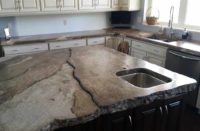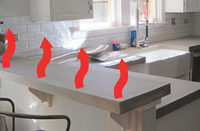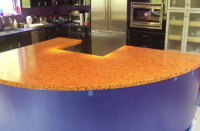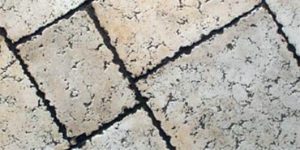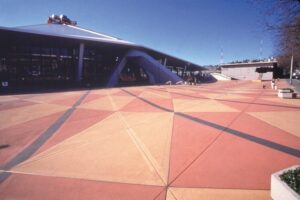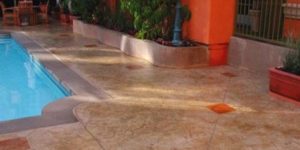Concrete Detail – Brattleboro, Vt.
This countertop design evokes the look of a lakeshore with integral color and acid stains, plus the homeowners’ collection of beach glass used as a creative custom aggregate.
Ingredients:
Custom wet-cast mix, two batches:
- Total Cementitious Binder (TCB) – 25% of batch – Comprised of:
- Type I/II portland cement – 20% of batch
- Class F fly ash (pozzolan) – 2.5% of batch
- VCAS (pozzolan) – 2.5% of batch
- 3/8-inch minus gravel – 38% of batch
- All-purpose sand (coarse/medium, bagged) – 20% of batch
- Mortar sand (fine, bagged) – 17% of batch
- Water – 33% of TCB
- Grace Advacast 555 superplasticizer/viscosity modifier — 1% of TCB
- Grace Eclipse shrinkage reducer – 1% of TCB
- Nycon Kuralon RECS15 PVA fiber – 0.8% of TCB
In one batch only:
- Blue Concrete iron oxide pigment: Walnut Brown, at 0.125% of TCB
- Concrete Countertop Supply iron oxide pigments: Yellow, at 0.75% of TCB and Light Red at 0.125% of TCB
- Beach glass, sorted by color
- 9-gauge ladder wire, cut to the shape of the countertop
- Concrete Depot acid stains: Southern Avocado, Bermuda Green and Malaysian Amber
- Baking soda solution (1 pound baking soda to 5 gallons water)
- Silpro C-21 All Acrylic admixture
- Kinloch EAP topical sealer, matte
- Denatured alcohol
- Required equipment: polyethelyne sheeting, hand-held wet grinder, diamond cup wheel, polishing pads up to 1,500 grit, 3M Gray Stone Polish Pad 4000
Directions:
- Build your wet-cast form. For this project, Concrete Detail cut the form out of 2-inch XPS foam sheets and secured them to a 3/4-inch melamine base sheet with double-sided carpet tape. Then they covered the form edges in vinyl tape and sealed the joints with silicone caulk. However you build your form, make sure you use a pencil to sketch out the boundaries for each band (one caramel-colored, one with the beach glass, and one plain gray) for guidance when placing the concrete.
- With your form upside down and ready to go, weigh out both batches of concrete (one with and one without pigment) and mix them at the same time, in separate barrel mixers.
- Place the caramel-colored batch first, in small handfuls, against the edge of the form, and fill out to the pencil boundary. Fill this band to a depth of 1.5 inches.
- Place the crushed beach glass in its designated zone in transitioning color groups and lock it into place with small handfuls of the gray concrete placed on top of it. Level this section off at 1.5 inches as well.
- Fill in the remaining band with gray concrete to 1.5 inches, and lay your wire reinforcing down, tying it off to the form to maintain its position.
- Then, color by color, fill the form up to the top.
- Vibrate the filled form to consolidate, and cover for the night with polyethylene sheeting.
- The next day strip the forms and carefully flip the casting. Wet it down, cover with a damp curing blanket, and rewrap it in the plastic sheeting again for several days.
- Once that time has passed, it’s time to finish what will be your countertop surface. Begin by wet-grinding with a diamond cup wheel and resin pads to expose the gravel in the caramel band and the beach glass on the border of the gray band – you’ll be able to see the beach glass beneath the surface, which will make it obvious where to grind. (The rest of the gray band should be left alone for acid staining later on.) Once you’ve exposed the glass and stone to the desired point, lightly wet-polish the entire surface and edges to 200 grit.
- Mix two slurry batches at the same ratio as the master batch – one with pigment and one without – using cement and the acrylic admixture. Mix them to the consistency of yogurt and with gloved hands rub them onto the surface, matching them to the color bands, and smooth with a putty knife. Do two coats, and allow the first to cure overnight and polish it off before repeating the process for the second. Let the twice-slurried, polished slab air-dry for one more night.
- For the final band of color, mask the caramel band and the beach-glass band with cardboard and apply your three stains with a small pump-up sprayer as desired.
- After two hours, scrub the area, neutralize it with your baking soda solution, rinse thoroughly and let dry overnight. The next day finish your surface with two thin coats of sealer, applied with an HVLP sprayer at a 70:30 dilution of Kinloch EAP topical sealer to denatured alcohol.
- After drying overnight, scuff the sealer with 1,500-grit wet/dry paper to knock down any dust motes, and finally, lightly rub the countertop with your 3M pad to even out the sheen.
